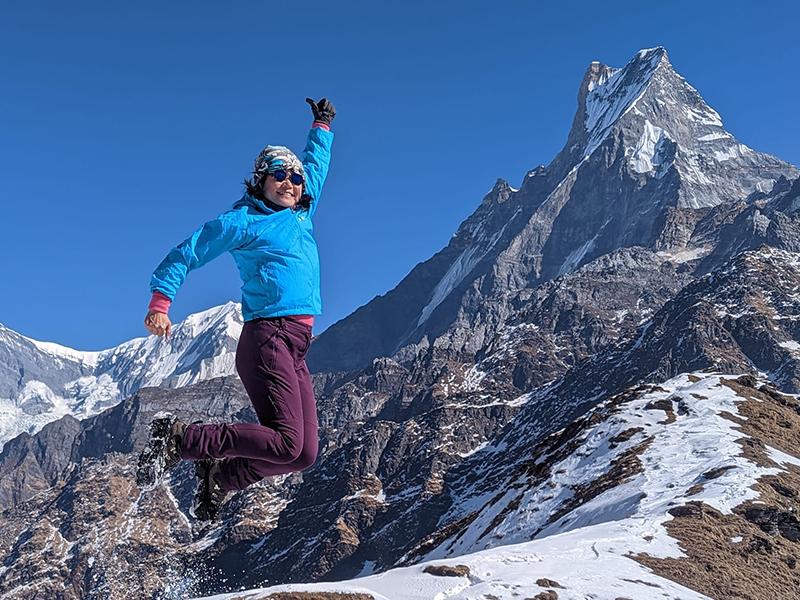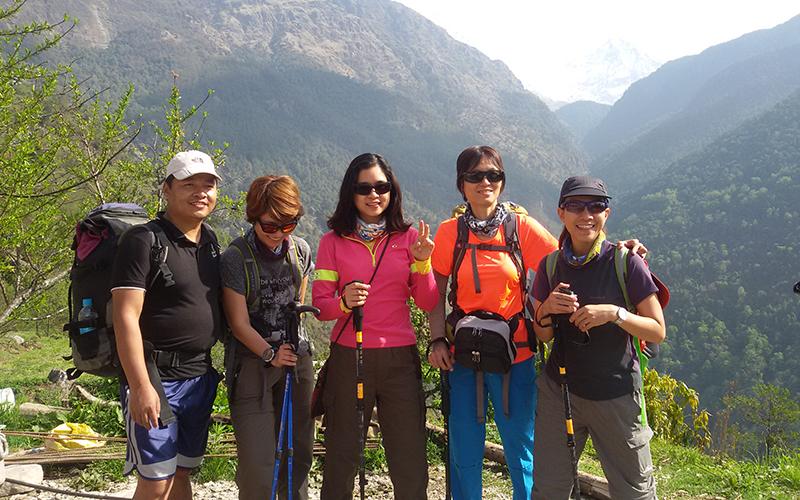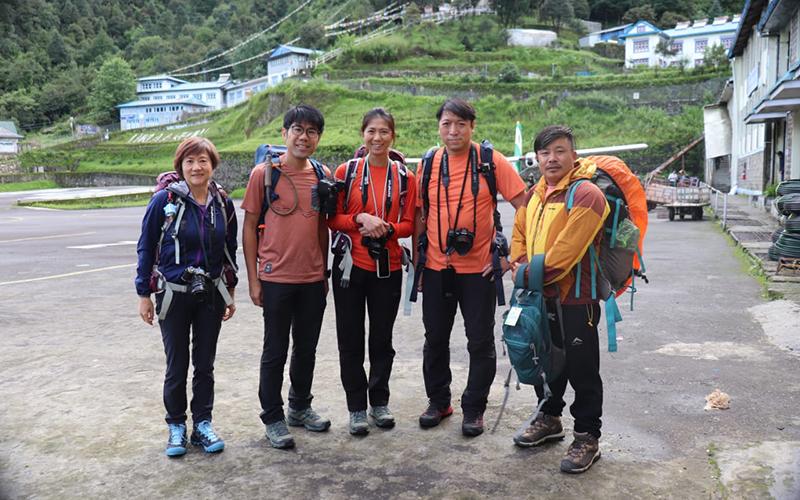Mardi Himal Trekking Packages

As of my last knowledge update in January 2024, the Mardi Himal Trek is a relatively new and less crowded trekking route in the Annapurna region of Nepal. The trek offers stunning views of the Annapurna and Machapuchare (Fishtail) peaks, as well as diverse landscapes, lush forests, and traditional villages.
Please note that specific trek packages and details may change over time, so it’s recommended to check with reputable trekking agencies or tour operators for the most up-to-date information. Here is a general outline of what a Mardi Himal Trek package might include:

Mardi Himal Trek 5 Days
A 5-day Mardi Himal Trek would be a shortened version of the standard trek and may involve a faster pace and less time for acclimatization. Here’s a sample itinerary for a 5-day Mardi Himal Trek:
5 Days Mardi Himal Itinerary
Day 01: Pokhara to Deurali (2100m). 4 hour
Day 02: Trek to Low Camp or Badal Dada (2970m) 5-6 hour
Day 03: Trek to High Camp (3550m) average 5-6hrs
Day 04: Hike to Mardi Himal Viewpoint (4000m.) and return to Low Camp 8 hrs
Day 05: Low Camp to Siding and drive to Pokhara 4-5 hour trek
Mardi Himal trek from Pokhara
The Mardi Himal Trek usually begins and ends in Pokhara, a popular tourist destination in Nepal. Below is a standard 5-day itinerary for the Mardi Himal Trek starting from and returning to Pokhara:
Please note that this is a general itinerary, and the trekking days may vary based on your pace and specific arrangements with the trekking agency. Always check with a reliable trekking agency to confirm the current trail conditions, necessary permits, and any other details before starting the trek. Additionally, it’s crucial to allow for acclimatization to higher altitudes, especially when trekking in the Himalayas.

Is the Mardi Himal trek difficult?
The Mardi Himal Trek is generally considered to be a moderate trek, making it suitable for trekkers with a moderate level of fitness and some trekking experience. However, the difficulty of the trek can vary depending on factors such as the chosen route, weather conditions, and individual fitness levels.
Here are some key points to consider regarding the difficulty of the Mardi Himal Trek:
Altitude:
While the highest point of the trek is Mardi Himal Base Camp at around 4,200 meters (14,763 feet), the trek does not involve prolonged exposure to very high altitudes. However, some people may still experience mild symptoms of altitude sickness, so it’s essential to acclimatize properly and pay attention to your body’s signals.
Terrain:
The trail passes through a variety of terrains, including forests, terraced fields, and alpine landscapes. Some sections may involve steep ascents and descents, but there are no technically challenging climbs or exposed ridges.
Duration:
The standard Mardi Himal Trek itinerary is around 4 to 5 days, allowing for a gradual ascent and acclimatization. However, shorter itineraries may increase the daily trekking distances and make the trek more challenging.
Weather:
Weather conditions can impact the difficulty of the trek. It’s important to be prepared for changes in weather, including rain and snow, especially during the trekking seasons.
Experience:
While the Mardi Himal Trek is considered suitable for trekkers with moderate fitness levels, having prior trekking experience can enhance your enjoyment and confidence on the trail.
Guided vs. Independent Trek:
Going with a reputable trekking agency and having an experienced guide can make the trek more manageable. Guides are familiar with the trail, can assist when needed, and ensure a safer and more enjoyable experience.
Where to start Mardi Trek?
The Mardi Himal Trek typically starts from Kande, which is accessible from Pokhara. Kande serves as the starting point for the trek and is located approximately 16 kilometers (10 miles) southwest of Pokhara. Trekkers usually reach Kande by private vehicle or taxi from Pokhara.
Here is a general overview of how to get to the starting point of the Mardi Himal Trek:
1. Kathmandu to Pokhara:
Most trekkers first arrive in Kathmandu, the capital of Nepal.
From Kathmandu, you can either take a scenic domestic flight to Pokhara or opt for a tourist bus, microbus, or private vehicle for the overland journey. The flight takes about 25-30 minutes, while the road journey takes approximately 6-8 hours, depending on the mode of transportation.
2. Pokhara:
Once you are in Pokhara, spend a day or two exploring the city and making any necessary preparations for the trek.
Ensure you have obtained the required permits for the Annapurna Conservation Area.
3. Pokhara to Kande:
From Pokhara, you’ll need to travel to Kande, the starting point of the Mardi Himal Trek.
Kande is approximately a 1-2 hour drive from Pokhara, and the journey involves picturesque views of the Annapurna Range.
Arrange for a private vehicle, taxi, or local transportation to take you from Pokhara to Kande.
4. Start of the Trek:
Once in Kande, you can begin your trek toward Mardi Himal.
The trail passes through lush forests, charming villages, and diverse landscapes as you ascend toward High Camp and Mardi Himal Base Camp.
Always make sure to check the current trail conditions, obtain the necessary permits, and consider hiring a local guide for a more enjoyable and safe trekking experience. It’s advisable to consult with a reputable trekking agency in Pokhara for the latest information and assistance in organizing your Mardi Himal Trek.
Which is the best time for Mardi Himal?
The best time to trek to Mardi Himal is during the pre-monsoon (spring) and post-monsoon (autumn) seasons in Nepal. The recommended months for the Mardi Himal Trek are:
Spring (Pre-Monsoon):
March to May is considered one of the best times for the Mardi Himal Trek.
During spring, the weather is generally stable, with clear skies and moderate temperatures.
The rhododendron forests along the trail are in full bloom, adding vibrant colors to the landscape.
The visibility is excellent, providing stunning views of the Annapurna and Machapuchare peaks.
Autumn (Post-Monsoon):
September to November is another optimal time for the Mardi Himal Trek.
Autumn offers stable weather conditions with clear skies and pleasant temperatures.
The post-monsoon period brings lush greenery to the landscapes, and the visibility is excellent for mountain views.
This season is popular among trekkers, and the trails are usually dry and stable.
These two seasons are considered the peak trekking seasons in Nepal due to favorable weather conditions. Trekkers can enjoy comfortable temperatures during the day and relatively clear skies, making it ideal for trekking and enjoying the breathtaking scenery.
Keep in mind that the Mardi Himal Trek is at higher altitudes, and conditions can change rapidly. It’s essential to be prepared for colder temperatures, especially at night, and to check weather forecasts before starting the trek. Additionally, during the winter months (December to February), the trail may be covered with snow, making it more challenging and requiring proper equipment.
How Much Does a Cost Mardi Himal Trek?
The cost of a Mardi Himal Trek can vary based on several factors, including the duration of the trek, the trekking agency chosen, the level of service provided, and the inclusions/exclusions in the package. Here are some general considerations:
Trekking Agency:
The choice of trekking agency plays a significant role in determining the cost. Reputable agencies with experienced guides and good services may charge more.
Duration of the Trek:
Longer itineraries with additional days may increase the overall cost of the trek.
Inclusions:
The inclusion of services such as transportation, permits, accommodation, meals, guides, and porters affects the overall cost. Full-service packages that include most or all of these elements tend to be more expensive.
Group Size:
The cost per person may vary depending on the size of the trekking group. Larger groups may receive group discounts, while smaller groups or solo trekkers might pay a bit more.
Time of the Year:
Prices can also vary depending on the season. Peak trekking seasons, such as spring and autumn, may see higher demand and slightly higher prices.
Equipment:
Some trekking agencies include trekking equipment like sleeping bags, while others may charge extra for such items.
As of my last knowledge update in January 2024, a rough estimate for a basic 4 to 5-day Mardi Himal Trek package with a reputable trekking agency might range from $350 to $400 per person. This estimate includes permits, accommodation, meals, guide, and porter services. Keep in mind that prices can change, and it’s crucial to get detailed quotes from trekking agencies.
Always inquire about what is included and excluded in the quoted price, and be clear about the services provided. It’s advisable to compare offerings from different agencies, read reviews, and ensure that the agency follows responsible tourism practices.
Please note that these are general estimates, and the actual cost can vary based on the factors mentioned above. It’s recommended to contact trekking agencies directly for the most accurate and up-to-date information on Mardi Himal Trek packages.






